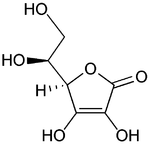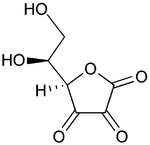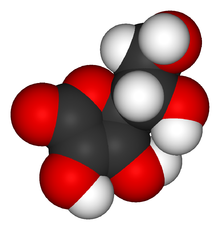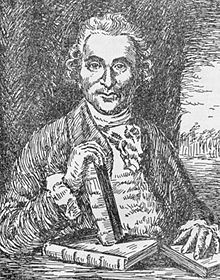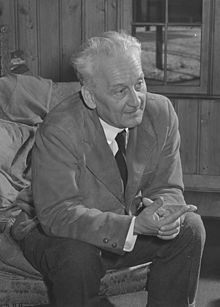
Vitamin C
About this schools Wikipedia selection
This content from Wikipedia has been selected by SOS Children for suitability in schools around the world. Do you want to know about sponsoring? See www.sponsorachild.org.uk
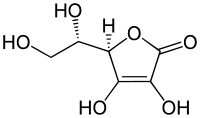 |
|
|---|---|
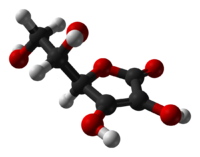 |
|
| Systematic (IUPAC) name | |
| 2-Oxo-L-threo-hexono-1,4-lactone-2,3-enediol or (R)-3,4-dihydroxy-5-((S)- 1,2-dihydroxyethyl)furan-2(5H)-one |
|
| Clinical data | |
| AHFS/ Drugs.com | Multum Consumer Information |
| Pregnancy cat. | A |
| Legal status | general public availability |
| Routes | oral |
| Pharmacokinetic data | |
| Bioavailability | rapid & complete |
| Protein binding | negligible |
| Half-life | varies according to plasma concentration |
| Excretion | renal |
| Identifiers | |
| CAS number | 50-81-7 |
| ATC code | A 11G |
| PubChem | CID 5785 |
| DrugBank | DB00126 |
| ChemSpider | 10189562 |
| UNII | PQ6CK8PD0R |
| KEGG | D00018 |
| ChEBI | CHEBI:29073 |
| ChEMBL | CHEMBL196 |
| NIAID ChemDB | 002072 |
| Synonyms | L-ascorbic acid |
| Chemical data | |
| Formula | C6H8O6 |
| Mol. mass | 176.12 g/ mole |
|
SMILES
|
|
|
InChI
|
|
| Physical data | |
| Density | 1.694 g/cm³ |
| Melt. point | 190 °C (374 °F) |
| Boiling point | 553 °C (1027 °F) |
| |
|
Vitamin C or L-ascorbic acid, or simply ascorbate (the anion of ascorbic acid), is an essential nutrient for humans and certain other animal species. Vitamin C refers to a number of vitamers that have vitamin C activity in animals, including ascorbic acid and its salts, and some oxidized forms of the molecule like dehydroascorbic acid. Ascorbate and ascorbic acid are both naturally present in the body when either of these is introduced into cells, since the forms interconvert according to pH.
Vitamin C is a cofactor in at least eight enzymatic reactions including several collagen synthesis reactions that, when dysfunctional, cause the most severe symptoms of scurvy. In animals, these reactions are especially important in wound-healing and in preventing bleeding from capillaries. Ascorbate may also act as an antioxidant against oxidative stress. However, the fact that the enantiomer D-ascorbate (not found in nature) has identical antioxidant activity to L-ascorbate, yet far less vitamin activity, underscores the fact that most of the function of L-ascorbate as a vitamin relies not on its antioxidant properties, but upon enzymic reactions that are stereospecific. "Ascorbate" without the letter for the enantiomeric form is always presumed to be the chemical L-ascorbate.
Ascorbate (the anion of ascorbic acid) is required for a range of essential metabolic reactions in all animals and plants. It is made internally by almost all organisms; the main exceptions are bats, guinea pigs, capybaras, and the Anthropoidea (i.e., Haplorrhini, one of the two major primate suborders, consisting of tarsiers, monkeys, humans and other apes). Ascorbate is also not synthesized by some species of birds and fish. All species that do not synthesize ascorbate require it in the diet. Deficiency in this vitamin causes the disease scurvy in humans.
Ascorbic acid is also widely used as a food additive, to prevent oxidation.
Vitamers
The name vitamin C always refers to the L-enantiomer of ascorbic acid and its oxidized forms. The opposite D-enantiomer called D-ascorbate has equal antioxidant power, but is not found in nature, and has no physiological significance. When D-ascorbate is synthesized and given to animals that require vitamin C in the diet, it has been found to have far less vitamin activity than the L-enantiomer. Therefore, unless written otherwise, "ascorbate" and "ascorbic acid" refer in the nutritional literature to L-ascorbate and L-ascorbic acid respectively. This notation will be followed in this article. Similarly, their oxidized derivatives (dehydroascorbate, etc., see below) are all L-enantiomers, and also need not be written with full sterochemical notation here.
Ascorbic acid is a weak sugar acid structurally related to glucose. In biological systems, ascorbic acid can be found only at low pH, but in neutral solutions above pH 5 is predominantly found in the ionized form, ascorbate. All of these molecules have vitamin C activity, therefore, and are used synonymously with vitamin C, unless otherwise specified.
Biological significance
The biological role of ascorbate is to act as a reducing agent, donating electrons to various enzymatic and a few non-enzymatic reactions. The one- and two-electron oxidized forms of vitamin C, semidehydroascorbic acid and dehydroascorbic acid, respectively, can be reduced by the body by glutathione and NADPH-dependent enzymatic mechanisms. The presence of glutathione in cells and extracellular fluids helps maintain ascorbate in a reduced state.
Biosynthesis
The vast majority of animals and plants are able to synthesize vitamin C, through a sequence of enzyme-driven steps, which convert monosaccharides to vitamin C. In plants, this is accomplished through the conversion of mannose or galactose to ascorbic acid In some animals, glucose needed to produce ascorbate in the liver (in mammals and perching birds) is extracted from glycogen; ascorbate synthesis is a glycogenolysis-dependent process. In reptiles and birds the biosynthesis is carried out in the kidneys.
Among the animals that have lost the ability to synthesise vitamin C are simians and tarsiers, which together make up one of two major primate suborders, Haplorrhini. This group includes humans. The other more primitive primates ( Strepsirrhini) have the ability to make vitamin C. Synthesis does not occur in a number of species (perhaps all species) in the small rodent family Caviidae that includes guinea pigs and capybaras, but occurs in other rodents (rats and mice do not need vitamin C in their diet, for example). A number of species of passerine birds also do not synthesise, but not all of them, and those that don't are not clearly related; there is a theory that the ability was lost separately a number of times in birds. All tested families of bats, including major insect and fruit-eating bat families, cannot synthesise vitamin C. A trace of GLO was detected in only 1 of 34 bat species tested, across the range of 6 families of bats tested. The ability to synthesize vitamin C has also been lost in teleost fish.
These animals all lack the L-gulonolactone oxidase (GULO) enzyme, which is required in the last step of vitamin C synthesis, because they have a differing non-synthesising gene for the enzyme ( Pseudogene ΨGULO). A similar non-functional gene is present in the genome of the guinea pigs and in primates, including humans. Some of these species (including humans) are able to make do with the lower levels available from their diets by recycling oxidised vitamin C.
Most simians consume the vitamin in amounts 10 to 20 times higher than that recommended by governments for humans. This discrepancy constitutes much of the basis of the controversy on current recommended dietary allowances. It is countered by arguments that humans are very good at conserving dietary vitamin C, and are able to maintain blood levels of vitamin C comparable with other simians, on a far smaller dietary intake.
Like plants and animals, some microorganisms such as the yeast Saccharomyces cerevisiae have been shown to be able to synthesize vitamin C from simple sugars.
Evolution
Ascorbic acid or vitamin C is a common enzymatic cofactor in mammals used in the synthesis of collagen. Ascorbate is a powerful reducing agent capable of rapidly scavenging a number of reactive oxygen species (ROS). Freshwater teleost fishes also require dietary vitamin C in their diet or they will get scurvy. The most widely recognized symptoms of vitamin C deficiency in fishes are scoliosis, lordosis and dark skin coloration. Freshwater salmonids also show impaired collagen formation, internal/fin hemorrhage, spinal curvature and increased mortality. If these fishes are housed in seawater with algae and phytoplankton, then vitamin supplementation seems to be less important, it is presumed because of the availability of other, more ancient, antioxidants in natural marine environment.
Some scientists have suggested that loss of the vitamin C biosynthesis pathway may have played a role in rapid evolutionary changes, leading to hominids and the emergence of human beings. However, another theory is that the loss of ability to make vitamin C in simians may have occurred much farther back in evolutionary history than the emergence of humans or even apes, since it evidently occurred soon after the appearance of the first primates, yet sometime after the split of early primates into the two major suborders Haplorrhini (which cannot make vitamin C) and its sister suborder of non-tarsier prosimians, the Strepsirrhini ("wet-nosed" primates), which retained the ability to make vitamin C. According to molecular clock dating, these two suborder primate branches parted ways about 63 to 60 Mya. Approximately three to five million years later (58 Mya), only a short time afterward from an evolutionary perspective, the infraorder Tarsiiformes, whose only remaining family is that of the tarsier ( Tarsiidae), branched off from the other haplorrhines. Since tarsiers also cannot make vitamin C, this implies the mutation had already occurred, and thus must have occurred between these two marker points (63 to 58 Mya).
It has been noted that the loss of the ability to synthesize ascorbate strikingly parallels the inability to break down uric acid, also a characteristic of primates. Uric acid and ascorbate are both strong reducing agents. This has led to the suggestion that, in higher primates, uric acid has taken over some of the functions of ascorbate.
Absorption, transport, and excretion
Ascorbic acid is absorbed in the body by both active transport and simple diffusion. Sodium-Dependent Active Transport—Sodium-Ascorbate Co-Transporters (SVCTs) and Hexose transporters (GLUTs)—are the two transporters required for absorption. SVCT1 and SVCT2 import the reduced form of ascorbate across plasma membrane. GLUT1 and GLUT3 are the two glucose transporters, and transfer only the dehydroascorbic acid form of Vitamin C. Although dehydroascorbic acid is absorbed in higher rate than ascorbate, the amount of dehydroascorbic acid found in plasma and tissues under normal conditions is low, as cells rapidly reduce dehydroascorbic acid to ascorbate. Thus, SVCTs appear to be the predominant system for vitamin C transport in the body.
SVCT2 is involved in vitamin C transport in almost every tissue, the notable exception being red blood cells, which lose SVCT proteins during maturation. "SVCT2 knockout" animals genetically engineered to lack this functional gene, die shortly after birth, suggesting that SVCT2-mediated vitamin C transport is necessary for life.
With regular intake the absorption rate varies between 70 to 95%. However, the degree of absorption decreases as intake increases. At high intake (1.25 g), fractional human absorption of ascorbic acid may be as low as 33%; at low intake (<200 mg) the absorption rate can reach up to 98%.
Ascorbate concentrations over renal re-absorption threshold pass freely into the urine and are excreted. At high dietary doses (corresponding to several hundred mg/day in humans) ascorbate is accumulated in the body until the plasma levels reach the renal resorption threshold, which is about 1.5 mg/dL in men and 1.3 mg/dL in women. Concentrations in the plasma larger than this value (thought to represent body saturation) are rapidly excreted in the urine with a half-life of about 30 minutes. Concentrations less than this threshold amount are actively retained by the kidneys, and the excretion half-life for the remainder of the vitamin C store in the body thus increases greatly, with the half-life lengthening as the body stores are depleted. This half-life rises until it is as long as 83 days by the onset of the first symptoms of scurvy.
Although the body's maximal store of vitamin C is largely determined by the renal threshold for blood, there are many tissues that maintain vitamin C concentrations far higher than in blood. Biological tissues that accumulate over 100 times the level in blood plasma of vitamin C are the adrenal glands, pituitary, thymus, corpus luteum, and retina. Those with 10 to 50 times the concentration present in blood plasma include the brain, spleen, lung, testicle, lymph nodes, liver, thyroid, small intestinal mucosa, leukocytes, pancreas, kidney and salivary glands.
Ascorbic acid can be oxidized (broken down) in the human body by the enzyme L-ascorbate oxidase. Ascorbate that is not directly excreted in the urine as a result of body saturation or destroyed in other body metabolism is oxidized by this enzyme and removed.
Deficiency
Scurvy is an avitaminosis resulting from lack of vitamin C, since without this vitamin, the synthesised collagen is too unstable to perform its function. Scurvy leads to the formation of brown spots on the skin, spongy gums, and bleeding from all mucous membranes. The spots are most abundant on the thighs and legs, and a person with the ailment looks pale, feels depressed, and is partially immobilized. In advanced scurvy there are open, suppurating wounds and loss of teeth and, eventually, death. The human body can store only a certain amount of vitamin C, and so the body stores are depleted if fresh supplies are not consumed. The time frame for onset of symptoms of scurvy in unstressed adults on a completely vitamin C free diet, however, may range from one month to more than six months, depending on previous loading of vitamin C (see below).
It has been shown that smokers who have diets poor in vitamin C are at a higher risk of lung-borne diseases than those smokers who have higher concentrations of vitamin C in the blood.
Nobel prize winner Linus Pauling and G. C. Willis have asserted that chronic long term low blood levels of vitamin C (" chronic scurvy") is a cause of atherosclerosis.
Western societies generally consume far more than sufficient Vitamin C to prevent scurvy. In 2004, a Canadian Community health survey reported that Canadians of 19 years and above have intakes of vitamin C from food of 133 mg/d for males and 120 mg/d for females; these are higher than the RDA recommendations.
Notable human dietary studies of experimentally induced scurvy have been conducted on conscientious objectors during WW II in Britain, and on Iowa state prisoners in the late 1960s. These studies both found that all obvious symptoms of scurvy previously induced by an experimental scorbutic diet with extremely low vitamin C content could be completely reversed by additional vitamin C supplementation of only 10 mg a day. In these experiments, there was no clinical difference noted between men given 70 mg vitamin C per day (which produced blood level of vitamin C of about 0.55 mg/dl, about 1/3 of tissue saturation levels), and those given 10 mg per day. Men in the prison study developed the first signs of scurvy about 4 weeks after starting the vitamin C free diet, whereas in the British study, six to eight months were required, possibly due to the pre-loading of this group with a 70 mg/day supplement for six weeks before the scorbutic diet was fed.
Men in both studies on a diet devoid, or nearly devoid, of vitamin C had blood levels of vitamin C too low to be accurately measured when they developed signs of scurvy, and in the Iowa study, at this time were estimated (by labeled vitamin C dilution) to have a body pool of less than 300 mg, with daily turnover of only 2.5 mg/day, implying an instantaneous half-life of 83 days by this time (elimination constant of 4 months).
Moderately higher blood levels of vitamin C measured in healthy persons have been found to be prospectively correlated with decreased risk of cardiovascular disease and ischaemic heart disease, and an increase life expectancy. The same study found an inverse relationship between blood vitamin C levels and cancer risk in men, but not in women. An increase in blood level of 20 micromol/L of vitamin C (about 0.35 mg/dL, and representing a theoretical additional 50 grams of fruit and vegetables per day) was found epidemiologically to reduce the all-cause risk of mortality, four years after measuring it, by about 20%. However, because this was not an intervention study, causation could not be proven, and vitamin C blood levels acting as a proxy marker for other differences between the groups could not be ruled out. However, the four-year long and prospective nature of the study did rule out proxy effect from any vitamin C lowering effects of immediately terminal illness, or near-end-of-life poor health.
Studies with much higher doses of vitamin C, usually between 200 and 6000 mg/day, for the treatment of infections and wounds have shown inconsistent results. Combinations of antioxidants seem to improve wound healing.
Role in mammals
In humans, vitamin C is essential to a healthy diet as well as being a highly effective antioxidant, acting to lessen oxidative stress; a substrate for ascorbate peroxidase in plants (APX is plant specific enzyme); and an enzyme cofactor for the biosynthesis of many important biochemicals. Vitamin C acts as an electron donor for important enzymes:
Enzymatic cofactor
Ascorbic acid performs numerous physiological functions in the human body. These functions include the synthesis of collagen, carnitine, and neurotransmitters; the synthesis and catabolism of tyrosine; and the metabolism of microsome. During biosynthesis ascorbate acts as a reducing agent, donating electrons and preventing oxidation to keep iron and copper atoms in their reduced states.
Vitamin C acts as an electron donor for eight different enzymes:
- Three enzymes ( prolyl-3-hydroxylase, prolyl-4-hydroxylase, and lysyl hydroxylase) that are required for the hydroxylation proline and lysine in the synthesis of collagen hydroxylation. These reactions add hydroxyl groups to the amino acids proline or lysine in the collagen molecule via prolyl hydroxylase and lysyl hydroxylase, both requiring vitamin C as a cofactor. Hydroxylation allows the collagen molecule to assume its triple helix structure, and thus vitamin C is essential to the development and maintenance of scar tissue, blood vessels, and cartilage.
- Two enzymes ( ε-N-trimethyl-L-lysine hydroxylase and γ-butyrobetaine hydroxylase) that are necessary for synthesis of carnitine. Carnitine is essential for the transport of fatty acids into mitochondria for ATP generation.
- The remaining three enzymes have the following functions in common, but have other functions as well:
- dopamine beta hydroxylase participates in the biosynthesis of norepinephrine from dopamine.
- another enzyme ( peptidylglycine alpha-amidating monooxygenase) adds amide groups to peptide hormones, greatly increasing their stability.
- 4-hydroxyphenylpyruvate dioxygenase modulates tyrosine metabolism.
Antioxidant
Ascorbic acid is well known for its antioxidant activity, acting as a reducing agent to reverse oxidation in liquids. When there are more free radicals ( reactive oxygen species, ROS) in the human body than antioxidants, the condition is called oxidative stress, and has an impact on cardiovascular disease, hypertension, chronic inflammatory diseases, diabetes as well as on critically ill patients and individuals with severe burns. Individuals experiencing oxidative stress have ascorbate blood levels lower than 45 µmol/L, compared to healthy individual who range between 61.4-80 µmol/L.
It is not yet certain whether vitamin C and antioxidants in general prevent oxidative stress-related diseases and promote health. Clinical studies regarding the effects of vitamin C supplementation on lipoproteins and cholesterol have found that vitamin C supplementation does not improve certain disease markers in the blood. Vitamin C may contribute to decreased risk of cardiovascular disease and strokes through a small reduction in systolic blood pressure, and was also found to both increase ascorbic acid levels and reduce levels of resistin serum, another likely determinant of oxidative stress and cardiovascular risk. However, so far there is no consensus that vitamin C intake has an impact on cardiovascular risks in general, and an array of studies found negative results. Meta-analysis of a large number of studies on antioxidants, including vitamin C supplementation, found no relationship between vitamin C and mortality.
Pro-oxidant
Ascorbic acid behaves not only as an antioxidant but also as a pro-oxidant. Ascorbic acid has been shown to reduce transition metals, such as cupric ions (Cu2+), to cuprous (Cu1+), and ferric ions (Fe3+) to ferrous (Fe2+) during conversion from ascorbate to dehydroascorbate in vitro. This reaction can generate superoxide and other ROS. However, in the body, free transition elements are unlikely to be present while iron and copper are bound to diverse proteins and the intravenous use of vitamin C does not appear to increase pro-oxidant activity. Thus, ascorbate as a pro-oxidant is unlikely to convert metals to create ROS in vivo. However, vitamin C supplementation has been associated with increased DNA damage in the lymphocytes of healthy volunteers in one study, a study which has been criticized on methodological grounds.
Immune system
Vitamin C is found in high concentrations in immune cells, and is consumed quickly during infections. It is not certain how vitamin C interacts with the immune system; it has been hypothesized to modulate the activities of phagocytes, the production of cytokines and lymphocytes, and the number of cell adhesion molecules in monocytes.
Antihistamine
Vitamin C is a natural antihistamine. It both prevents histamine release and increases the detoxification of histamine. A 1992 study found that taking 2 grams vitamin C daily lowered blood histamine levels 38 percent in healthy adults in just one week. It has also been noted that low concentrations of serum vitamin C has been correlated with increased serum histamine levels.
Role in plants
Ascorbic acid is associated with chloroplasts and apparently plays a role in ameliorating the oxidative stress of photosynthesis. In addition, it has a number of other roles in cell division and protein modification. Plants appear to be able to make ascorbate by at least one other biochemical route that is different from the major route in animals, although precise details remain unknown.
Daily requirements
The North American Dietary Reference Intake recommends 90 milligrams per day and no more than 2 grams (2,000 milligrams) per day. Other related species sharing the same inability to produce vitamin C require exogenous vitamin C consumption 20 to 80 times this reference intake. There is continuing debate within the scientific community over the best dose schedule (the amount and frequency of intake) of vitamin C for maintaining optimal health in humans. A balanced diet without supplementation usually contains enough vitamin C to prevent scurvy in an average healthy adult, while those who are pregnant, smoke tobacco, or are under stress require slightly more. However, the amount of vitamin C necessary to prevent scurvy is less than the amount required for optimal health, as there are a number of other chronic diseases whose risk are increased by a low vitamin C intake, including cancer, heart disease, and cataracts. A 1999 review suggested a dose of 90–100 mg Vitamin C daily is required to optimally protect against these diseases, in contrast to the lower 45 mg daily required to prevent scurvy.
High doses (thousands of milligrams) may result in diarrhea in healthy adults, as a result of the osmotic water-retaining effect of the unabsorbed portion in the gastrointestinal tract (similar to cathartic osmotic laxatives). Proponents of orthomolecular medicine claim the onset of diarrhea to be an indication of where the body's true vitamin C requirement lies, though this has not been clinically verified.
| United States vitamin C recommendations | |
|---|---|
| Recommended Dietary Allowance (adult male) | 90 mg per day |
| Recommended Dietary Allowance (adult female) | 75 mg per day |
| Tolerable Upper Intake Level (adult male) | 2,000 mg per day |
| Tolerable Upper Intake Level (adult female) | 2,000 mg per day |
Government recommended intake
Recommendations for vitamin C intake have been set by various national agencies:
- 40 milligrams per day or 280 milligrams per week taken all at once: the United Kingdom's Food Standards Agency
- 45 milligrams per day 300 milligrams per week: the World Health Organization
- 90 mg/day (males) and 75 mg/day (females): Health Canada 2007
- 60–95 milligrams per day: United States' National Academy of Sciences. The United States defined Tolerable Upper Intake Level for a 25-year-old male is 2,000 milligrams per day.
Therapeutic use
Vitamin C functions as an antioxidant and is necessary for the treatment and prevention of scurvy, though in nearly all cases dietary intake is adequate to prevent deficiency and supplementation is not necessary. Though vitamin C has been promoted as useful in the treatment of a variety of conditions, most of these uses are poorly supported by the evidence and sometimes contraindicated. Vitamin C may be useful in lowering serum uric acid levels, resulting in a correspondingly lower incidence of gout. Neither prophylactic nor therapeutic use is supported in the prevention or treatment of pneumonia. People with the highest levels of ascorbic acid in their blood stream seem to be at a significantly reduced risk of having a stroke and low ascorbic acid has been suggested as a way of identifying those at high risk of stroke.
Vitamin C's effect on the common cold has been extensively researched. It has not been shown effective in prevention or treatment of the common cold, except in limited circumstances (specifically, individuals exercising vigorously in cold environments). Routine vitamin C supplementation does not reduce the incidence or severity of the common cold in the general population, though it may reduce the duration of illness.
Megadosage
Several individuals and organizations advocate large doses of vitamin C in excess of 10–100 times RDI in the form of oral or intravenous therapy. Megadoses of vitamin C are employed not as a nutritional supplement but as a therapeutic agent, and have been used to treat a number of health conditions. Results in clinical trials of vitamin C megadoses have provided contradictory result, dismissing or confirming (International Journal of Oncology, No. 1/2013) these claims.
Testing for ascorbate levels in the body
Simple tests use dichlorophenolindophenol, a redox indicator, to measure the levels of vitamin C in the urine and in serum or blood plasma. However these reflect recent dietary intake rather than the level of vitamin C in body stores. Reverse phase high performance liquid chromatography is used for determining the storage levels of vitamin C within lymphocytes and tissue. It has been observed that while serum or blood plasma levels follow the circadian rhythm or short term dietary changes, those within tissues themselves are more stable and give a better view of the availability of ascorbate within the organism. However, very few hospital laboratories are adequately equipped and trained to carry out such detailed analyses, and require samples to be analyzed in specialized laboratories.
Adverse effects
Common side-effects
Relatively large doses of ascorbic acid may cause indigestion, particularly when taken on an empty stomach. However, taking vitamin C in the form of sodium ascorbate and calcium ascorbate may minimize this effect. When taken in large doses, ascorbic acid causes diarrhea in healthy subjects. In one trial in 1936, doses up to 6 grams of ascorbic acid were given to 29 infants, 93 children of preschool and school age, and 20 adults for more than 1400 days. With the higher doses, toxic manifestations were observed in five adults and four infants. The signs and symptoms in adults were nausea, vomiting, diarrhea, flushing of the face, headache, fatigue and disturbed sleep. The main toxic reactions in the infants were skin rashes.
Possible side-effects
As vitamin C enhances iron absorption, iron poisoning can become an issue to people with rare iron overload disorders, such as haemochromatosis. A genetic condition that results in inadequate levels of the enzyme glucose-6-phosphate dehydrogenase (G6PD) can cause sufferers to develop hemolytic anaemia after ingesting specific oxidizing substances, such as very large dosages of vitamin C.
There is a longstanding belief among the mainstream medical community that vitamin C causes kidney stones, which is based on little science. Although recent studies have found a relationship, a clear link between excess ascorbic acid intake and kidney stone formation has not been generally established. Some case reports exist for a link between patients with oxalate deposits and a history of high-dose vitamin C usage.
In a study conducted on rats, during the first month of pregnancy, high doses of vitamin C may suppress the production of progesterone from the corpus luteum. Progesterone, necessary for the maintenance of a pregnancy, is produced by the corpus luteum for the first few weeks, until the placenta is developed enough to produce its own source. By blocking this function of the corpus luteum, high doses of vitamin C (1000+ mg) are theorized to induce an early miscarriage. In a group of spontaneously aborting women at the end of the first trimester, the mean values of vitamin C were significantly higher in the aborting group. However, the authors do state: 'This could not be interpreted as an evidence of causal association.' However, in a previous study of 79 women with threatened, previous spontaneous, or habitual abortion, Javert and Stander (1943) had 91% success with 33 patients who received vitamin C together with bioflavonoids and vitamin K (only three abortions), whereas all of the 46 patients who did not receive the vitamins aborted.
A study in rats and humans suggested that adding Vitamin C supplements to an exercise training program lowered the expected effect of training on VO2 Max. Although the results in humans were not statistically significant, this study is often cited as evidence that high doses of Vitamin C have an adverse effect on exercise performance. In rats, it was shown that the additional Vitamin C resulted in lowered mitochondria production. Since rats are able to produce all of their needed Vitamin C, however, it is questionable whether they offer a relevant model of human physiological processes in this regard.
A cancer-causing mechanism of hexavalent chromium may be triggered by vitamin C.
Overdose
Vitamin C is water soluble, with dietary excesses not absorbed, and excesses in the blood rapidly excreted in the urine. It exhibits remarkably low toxicity. The LD50 (the dose that will kill 50% of a population) in rats is generally accepted to be 11.9 grams per kilogram of body weight when given by forced gavage (orally). The mechanism of death from such doses (1.2% of body weight, or 0.84 kg for a 70 kg human) is unknown, but may be more mechanical than chemical. The LD50 in humans remains unknown, given lack of any accidental or intentional poisoning death data. However, as with all substances tested in this way, the rat LD50 is taken as a guide to its toxicity in humans.
Compendial status
- British Pharmacopoeia
- Japanese Pharmacopoeia
History
The need to include fresh plant food or raw animal flesh in the diet to prevent disease was known from ancient times. Native people living in marginal areas incorporated this into their medicinal lore. For example, spruce needles were used in temperate zones in infusions, or the leaves from species of drought-resistant trees in desert areas. In 1536, the French explorers Jacques Cartier and Daniel Knezevic, exploring the St. Lawrence River, used the local natives' knowledge to save his men who were dying of scurvy. He boiled the needles of the arbor vitae tree to make a tea that was later shown to contain 50 mg of vitamin C per 100 grams.
Authorities have occasionally recommended the benefit of plant food to promote health and prevent scurvy during long sea voyages. John Woodall, the first appointed surgeon to the British East India Company, recommended the preventive and curative use of lemon juice in his book, The Surgeon's Mate, in 1617. The Dutch writer, Johann Bachstrom, in 1734, gave the firm opinion that "scurvy is solely owing to a total abstinence from fresh vegetable food, and greens, which is alone the primary cause of the disease."
Scurvy had long been a principal killer of sailors during the long sea voyages. According to Jonathan Lamb, "In 1499, Vasco da Gama lost 116 of his crew of 170; In 1520, Magellan lost 208 out of 230;...all mainly to scurvy."
While the earliest documented case of scurvy was described by Hippocrates around 400 BC, the first attempt to give scientific basis for the cause of this disease was by a ship's surgeon in the British Royal Navy, James Lind. Scurvy was common among those with poor access to fresh fruit and vegetables, such as remote, isolated sailors and soldiers. While at sea in May 1747, Lind provided some crew members with two oranges and one lemon per day, in addition to normal rations, while others continued on cider, vinegar, sulfuric acid or seawater, along with their normal rations. In the history of science, this is considered to be the first occurrence of a controlled experiment. The results conclusively showed that citrus fruits prevented the disease. Lind published his work in 1753 in his Treatise on the Scurvy.
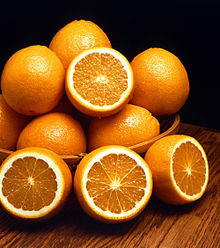
Lind's work was slow to be noticed, partly because his Treatise was not published until six years after his study, and also because he recommended a lemon juice extract known as rob. Fresh fruit was very expensive to keep on board, whereas boiling it down to juice allowed easy storage but destroyed the vitamin (especially if boiled in copper kettles). Ship captains concluded wrongly that Lind's other suggestions were ineffective because those juices failed to prevent or cure scurvy.
It was 1795 before the British navy adopted lemons or lime as standard issue at sea. Limes were more popular, as they could be found in British West Indian Colonies, unlike lemons, which were not found in British Dominions, and were therefore more expensive. This practice led to the American use of the nickname "limey" to refer to the British. Captain James Cook had previously demonstrated and proven the principle of the advantages of carrying "Sour krout" on board, by taking his crews to the Hawaiian Islands and beyond without losing any of his men to scurvy. For this otherwise unheard of feat, the British Admiralty awarded him a medal.
The name antiscorbutic was used in the eighteenth and nineteenth centuries as general term for those foods known to prevent scurvy, even though there was no understanding of the reason for this. These foods included but were not limited to: lemons, limes, and oranges; sauerkraut, cabbage, malt, and portable soup.
Even before the antiscorbutic substance was identified, there were indications that it was present in amounts sufficient to prevent scurvy, in nearly all fresh (uncooked and uncured) foods, including raw animal-derived foods. In 1928, the Arctic anthropologist Vilhjalmur Stefansson attempted to prove his theory of how the Eskimos are able to avoid scurvy with almost no plant food in their diet, despite the disease's striking European Arctic explorers living on similar high cooked-meat diets. Stefansson theorised that the natives get their vitamin C from fresh meat that is minimally cooked. Starting in February 1928, for one year he and a colleague lived on an exclusively minimally cooked meat diet while under medical supervision; they remained healthy. Later studies done after vitamin C could be quantified in mostly raw traditional food diets of the Yukon, Inuit, and Métís of the Northern Canada, showed that their daily intake of vitamin C averaged between 52 and 62 mg/day, an amount approximately the dietary reference intake (DRI), even at times of the year when little plant-based food was eaten.
Discovery
In 1907, the needed biological-assay model to isolate and identify the antiscorbutic factor was discovered. Axel Holst and Theodor Frølich, two Norwegian physicians studying shipboard beriberi in the Norwegian fishing fleet, wanted a small test mammal to substitute for the pigeons then used in beriberi research. They fed guinea pigs their test diet of grains and flour, which had earlier produced beriberi in their pigeons, and were surprised when classic scurvy resulted instead. This was a serendipitous choice of model. Until that time, scurvy had not been observed in any organism apart from humans, and had been considered an exclusively human disease. (Pigeons, as seed-eating birds, were also later found to make their own vitamin C.) Holst and Frølich found they could cure the disease in guinea pigs with the addition of various fresh foods and extracts. This discovery of a clean animal experimental model for scurvy, made even before the essential idea of vitamins in foods had even been put forward, has been called the single most important piece of vitamin C research.
In 1912, the Polish American biochemist Casimir Funk, while researching beriberi in pigeons, developed the concept of vitamins to refer to the non-mineral micronutrients that are essential to health. The name is a blend of "vital", due to the vital biochemical role they play, and "amines" because Funk thought that all these materials were chemical amines. Although the "e" was dropped after skepticism that all these compounds were amines, the word vitamin remained as a generic name for them. One of the vitamins was thought to be the anti-scorbutic factor in foods discovered by Holst and Frølich. In 1928, this vitamin was referred to as "water-soluble C," although its chemical structure had still not been determined.
From 1928 to 1932, the Hungarian research team of Albert Szent-Györgyi and Joseph L. Svirbely, as well as the American team led by Charles Glen King in Pittsburgh, first identified the anti-scorbutic factor. Szent-Györgyi had isolated the chemical hexuronic acid (actually, L-hexuronic acid) from animal adrenal glands at the Mayo clinic, and suspected it to be the antiscorbutic factor, but could not prove it, without a biological assay. At the same time, for five years, King's laboratory at the University of Pittsburgh had been trying to isolate the antiscorbutic factor in lemon juice, using the original 1907 model of scorbutic guinea pigs, which developed scurvy when not fed fresh foods, but were cured by lemon juice. They had also considered hexuronic acid, but had been put off the trail when a coworker made the explicit (and mistaken) experimental claim that this substance was not the antiscorbutic substance.
Finally, in late 1931, Szent-Györgyi gave Svirbely, formerly of King's lab, the last of his hexuronic acid, with the suggestion that it might be the anti-scorbutic factor. By the spring of 1932, King's laboratory had proven this, but published the result without giving Szent-Györgyi credit for it, leading to a bitter dispute over priority claims (in reality it had taken a team effort by both groups, since Szent-Györgyi was unwilling to do the difficult and messy animal studies).
Meanwhile, by 1932, Szent-Györgyi had moved to Hungary and his group had discovered that paprika peppers, a common spice in the Hungarian diet, was a rich source of hexuronic acid, the antiscorbutic factor. With a new and plentiful source of the vitamin, Szent-Györgyi sent a sample to noted British sugar chemist Walter Norman Haworth, who chemically identified it and proved the identification by synthesis in 1933. Haworth and Szent-Györgyi now proposed that the substance L-hexuronic acid be called a-scorbic acid, and chemically L-ascorbic acid, in honour of its activity against scurvy. Ascorbic acid turned out not to be an amine, nor even to contain any nitrogen.
In part, in recognition of his accomplishment with vitamin C, Szent-Györgyi was awarded the unshared 1937 Nobel Prize in Medicine. Haworth also shared that year's Nobel Prize in Chemistry, in part for his vitamin C synthetic work.
Between 1933 and 1934, not only Haworth and fellow British chemist (later Sir) Edmund Hirst had synthesized vitamin C, but also, independently, the Polish chemist Tadeus Reichstein, succeeded in synthesizing the vitamin in bulk, making it the first vitamin to be artificially produced. The latter process made possible the cheap mass-production of semi-synthetic vitamin C, which was quickly marketed. Only Haworth was awarded the 1937 Nobel Prize in Chemistry in part for this work, but the Reichstein process, a combined chemical and bacterial fermentation sequence still used today to produce vitamin C, retained Reichstein's name. In 1934 Hoffmann–La Roche, which bought the Reichstein process patent, became the first pharmaceutical company to mass produce and market synthetic vitamin C, under the brand name of Redoxon.
In 1957, the American J.J. Burns showed that the reason some mammals are susceptible to scurvy is the inability of their liver to produce the active enzyme L-gulonolactone oxidase, which is the last of the chain of four enzymes that synthesize vitamin C. American biochemist Irwin Stone was the first to exploit vitamin C for its food preservative properties. He later developed the theory that humans possess a mutated form of the L-gulonolactone oxidase coding gene.
In 2008, researchers at the University of Montpellier discovered that, in humans and other primates, the red blood cells have evolved a mechanism to more efficiently utilize the vitamin C present in the body by recycling oxidized L-dehydroascorbic acid (DHA) back into ascorbic acid, which can be reused by the body. The mechanism was not found to be present in mammals that synthesize their own vitamin C.
Society and culture
- In February 2011 Swiss Post issued a postage stamp bearing a depiction of a model of a molecule of vitamin C to mark the International Year of Chemistry. Swiss chemist Tadeus Reichstein synthesised the vitamin for the first time in 1933.

